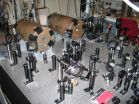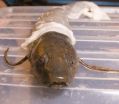(Press-News.org) Researchers from the Niels Bohr Institute at the University of Copenhagen have succeeded in storing quantum information using two 'entangled' light beams. Quantum memory or information storage is a necessary element of future quantum communication networks. The new findings are published in Nature Physics.
Quantum networks will be able to protect the security of information better than the current conventional communication networks. The cornerstone of quantum communication is a phenomenon called entanglement between two quantum systems, for example, two light beams. Entanglement means that the two light beams are connected to each other, so that they have well defined common characteristics, a kind of common knowledge. A quantum state can – according to the laws of quantum mechanics, not be copied and can therefore be used to transfer data in a secure way.
In professor Eugene Polzik's research group Quantop at the Niels Bohr Institute researchers have now been able to store the two entangled light beams in two quantum memories. The research is conducted in a laboratory where a forest of mirrors and optical elements such as wave plates, beam splitters, lenses etc. are set up on a large table, sending the light around on a more than 10 meter long labyrinthine journey. Using the optical elements, the researchers control the light and regulate the size and intensity to get just the right wavelength and polarisation the light needs to have for the experiment.
The two entangled light beams are created by sending a single blue light beam through a crystal where the blue light beam is split up into two red light beams. The two red light beams are entangled, so they have a common quantum state. The quantum state itself is information.
The two light beams are sent on through the labyrinth of mirrors and optical elements and reach the two memories, which in the experiment are two glass containers filled with a gas of caesium atoms. The atoms' quantum state contains information in the form of a so-called spin, which can be either 'up' or 'down'. It can be compared with computer data, which consists of the digits 0 and 1. When the light beams pass the atoms, the quantum state is transferred from the two light beams to the two memories. The information has thus been stored as the new quantum state in the atoms.
"For the first time such a memory has been demonstrated with a very high degree of reliability. In fact, it is so good that it is impossible to obtain with conventional memory for light that is used in, for example, internet communication. This result means that a quantum network is one step closer to being a reality", explains professor Eugene Polzik.
INFORMATION:
Contact:
Eugene Polzik, professor, Quantop, Niels Bohr Institute, University of Copenhagen, +45 3532-5424, +45 2338-2045, polzik@nbi.dk
Kasper Jensen, Ph.D. student Quantop, Niels Bohr Institute, University of Copenhagen, +45 3026-3149, +45 3532-5333, kjensen@nbi.dk
Artikel i Nature Physics >> http://dx.doi.org/10.1038/NPHYS1819
Quantum memory for communication networks of the future
2010-11-09
ELSE PRESS RELEASES FROM THIS DATE:
Graphene gets a Teflon makeover
2010-11-09
Professor Andre Geim, who along with his colleague Professor Kostya Novoselov won the 2010 Nobel Prize for graphene – the world's thinnest material, has now modified it to make fluorographene – a one-molecule-thick material chemically similar to Teflon.
Fluorographene is fully-fluorinated graphene and is basically a two-dimensional version of Teflon, showing similar properties including chemical inertness and thermal stability.
The results are this week reported in the advanced online issue of the journal Small. The work is a large international effort and involved ...
Were our tetrapod ancestors deaf?
2010-11-09
Many changes in the sensory systems of tetrapods are associated with the water-to-land transition. In hearing, one of the crucial elements in detecting airborne sound is the tympanic ear. Surprisingly, the tympanic ear originated independently in the major tetrapod lineages and relatively late after the terrestrial tetrapods emerged – in the Triassic, more than 100 million years after the origin of tetrapods. The major question raised by the researchers Jakob Christensen-Dalsgaard, Christian Brandt and Magnus Wahlberg, University of Southern Denmark, and Maria Wilson and ...
Privacy safeguards in Canadian military insufficient: Updated rules needed
2010-11-09
Privacy legislation and protocols to safeguard the health information of members of the military are lacking, and the head of Canada's military must take action to ensure health privacy for all staff, states an editorial in the Canadian Medical Association Journal (CAMJ) http://www.cmaj.ca/cgi/doi/10.1503/cmaj.101630.
Recent violations at Veterans Affairs Canada of privacy regarding sensitive health information raise questions about the military's ability to protect personal health information.
"Few of the world's armed forces provide complete confidentiality of personal ...
Mild painkillers in pregnancy are associated with an increased risk of male reproductive problems
2010-11-09
New evidence has emerged that the use of mild painkillers such as paracetamol, aspirin and ibuprofen, may be part of the reason for the increase in male reproductive disorders in recent decades. Research published in Europe's leading reproductive medicine journal Human Reproduction today (Monday 8 November) shows that women who took a combination of more than one mild analgesic during pregnancy, or who took the painkillers during the second trimester of pregnancy, had an increased risk of giving birth to sons with undescended testicles (cryptorchidism) – a condition that ...
Scientists pinpoint key defense against parasite infection
2010-11-09
Scientists have made a significant discovery about how the body defends itself against snail fever, a parasitic worm infection common in developing countries.
Researchers studied the immune response in mice infected with snail fever parasites. They found that a particular type of immune cell, known as the dendritic cell, is responsible for triggering the immune system's defence against the invading parasite.
The development, by scientists at the University of Edinburgh, could point towards new avenues of research into treatments for the condition, which causes long-term ...
Study examines risk of heterosexual HIV transmission in China
2010-11-09
A new study by researchers at the Johns Hopkins Bloomberg School of Public Health examines the burden of HIV and sexually transmitted disease among male clients of the commercial sex industry in China's Sichuan province. Since 2007, heterosexual transmission has replaced injecting drug use as the primary transmission mode of all HIV infections in China. The study is available online in advance of publication in the journal Sexually Transmitted Infections.
"We found a large burden of syphilis infection coupled with high-risk sexual and substance use behaviors among male ...
Scientist chronicle nanoparticles' journey from the lungs into the body
2010-11-09
BOSTON – Using a novel, real-time imaging system, scientists have tracked a group of near-infrared fluorescent nanoparticles from the airspaces of the lungs, into the body and out again, providing a description of the characteristics and behavior of these minute particles which could be used in developing therapeutic agents to treat pulmonary disease, as well as offering a greater understanding of the health effects of air pollution.
Led by investigators at Beth Israel Deaconess Medical Center (BIDMC) and the Harvard School of Public Health, the findings are described ...
Climate change: Water reservoir glacier
2010-11-09
Glaciers of large mountain regions contribute, to some extent considerably, to the water supply of certain populated areas. However, in a recent study conducted by Innsbruck glaciologists and climatologists it has been shown that there are important regional differences. The results of the study are published in the scientific journal Proceedings of the National Academy of Sciences (PNAS).
In their recently published study the glaciologists and climatologists, headed by Prof. Georg Kaser and Dr. Ben Marzeion from the Institute of Geography of the University of Innsbruck, ...
Close up on hidden galaxies with new cosmic zoom lenses
2010-11-09
Astronomers have discovered a new way of locating a natural phenomenon that acts like a zoom lens and allows astronomers to peer at galaxies in the distant and early Universe. These results are from the very first data taken as part of the "Herschel-ATLAS" project, the largest imaging survey conducted so far with the European Space Agency's Herschel Space Observatory, and are published today (November 4 2010) in the prestigious scientific journal Science.
The magnification allows astronomers to see galaxies otherwise hidden from us when the Universe was only a few billion ...
The economic causes and consequences of envy
2010-11-09
The use of experimental techniques in Economics in recent years has demonstrated that decision making of individuals' is guided not only by an individual's own benefit, but also by material gains that other individuals can have in their social network; in a nutshell, out of envy. But within this research framework there is still another challenge: the discovery of the evolutionary origin of envy and theoretical proof of its possible effects on companies. This is what Antonio Cabrales, Full Professor of the UC3M Economics Department, has tried to do in a new research ...



